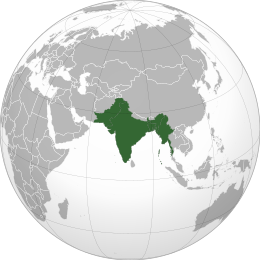More languages
More actions
| British Raj برطانوی راج | |
|---|---|
|
Civil ensign | |
 | |
| Capital | New Delhi |
| Official languages | English Urdu |
| Dominant mode of production | Capitalism |
| Government | Colonial occupation |
The British Raj was the period of direct British colonial rule on the Indian subcontinent. It succeeded the British East India Company's rule of India during the late Mughal Empire. During this period, India spent 25% and tax revenues on the military and barely 3% on health, education, and farming combined. British trade destroyed native Indian industries and undeveloped India's economy, increased the amount of Indians reliant on agriculture from 50% to 75%.[1] After 200 years of British occupation, the Indian literacy rate was only 12%.[2]
History
Formation
Following a rebellion of sepoys in 1857, the British government replaced the East India Company as the ruler of India and Queen Victoria Hanover became the Empress of India.[1]
Famines
Famines killed a million Indians in the 1860s, 3.5 million in the 1870s, and 10 million in the 1890s.[1]
Government
Following the end of company rule, the British strengthened their connections to native Indian rulers and relied on Brahmins to collect taxes and rents.[1]
Further reading
References
- ↑ 1.0 1.1 1.2 1.3 Neil Faulkner (2013). A Marxist History of the World: From Neanderthals to Neoliberals: 'The Age of Blood and Iron' (pp. 151–152). [PDF] Pluto Press. ISBN 9781849648639 [LG]
- ↑ Vijay Prashad (2017). Red Star over the Third World: 'Peasant Soviets' (pp. 59–60). [PDF] New Delhi: LeftWord Books.

